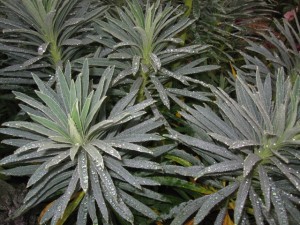During this eerily mild spell of January weather I am getting ahead of myself in the garden. Firstly I have walked around the garden making a list – it is a long list but I think it looks worse than it is.
If you don’t already have a ‘garden notepad’ January is a nice time to begin one). It is an important long term resource recording information such as which species of plants I have planted (instead of having unsightly labels in the garden and for when the plant tags get lost), seeds I have previously ordered, potato varieties I have had success (and failures) with, crop rotational plans, clippings from gardening magazines…
You can’t plant a garden and then turn your back on it, there will always be plants to move, weeds to get on top of, pruning, tidying… However, as gardeners, we do need to protect our soil by not walking and digging it when it is very wet like it is now. I have made the most of the paths and hard surfaces around my garden to access beds, one benefit of not having lawn everywhere!
I don’t aim to be too tidy either, dead leaves covering the soil (including flopped dead leaves and stems of Geranium, Iris siberica…) are all doing good in protecting the soil structure and providing shelter for invertebrates and amphibians which also means rich hunting ground for blackbirds…
The jobs on my list this month fall into the following categories:
Moving plants – sometimes I get things wrong, for example planting a Geranium ‘Rozanne’ too close to the edge of the bed so it gets in the way of mowing in the summer or the pink phlox which I have decided I don’t like.
Tree seedlings such as hazel will be moved to the hedgerow.
My hellebores have seeded everywhere as have Myosotis (forget- me-nots), Lunaria (Honesty) and Lychnis flos cuculi (ragged robin); primulas, Anenome and Digitalis purpurea (foxgloves) have wandered too. I weed out most of the Myosotis (but not all), move, thin and pot up the rest for the Shepton Horticultural Society summer plant sale.
Seed heads – my secateurs hover over the untidy Verbena bonariensis however I resist because I have seen the greenfinches enjoying a valuable feast of its seeds. The Delphinium stems do get a rough tidy but I am wary because these hollow stems will be providing habitat to some tiny insect species I am sure.
Most of the seed heads are safe for a while longer with species like Hydrangea, Primula florindae, Sedum, Actaea and Iris foetidissima all providing interest. I do admit though that Iris foretidissima tends to seed a bit too happily in my garden so I have harvested its bright orange seed heads to bring into the house as decoration, its evergreen, strong, strappy leaves are a great asset to form in the borders.
Being ruthless – take a critical look at the garden, is anything underperforming? For example Rosa ‘Charles de Mills’ is a large plant and only flowers once, I have decided I only have space for one of these. The Phlomis fruticosa I grew from a cutting doesn’t really fit with my garden (and it wants to grow big!), it will have to go to the plant sale.
Weeds – We don’t want to damage our soil by trampling and digging this month, so any patches of bind weed and ground elder will have to wait, in the meantime that ephemeral little weed Cardamine hirsuta (hairy bitter cress) can be pulled up (it has an 8 week life cycle so your job will never be done!) and maybe make a start on any Ranunculus repens (creeping buttercup) using a hand fork.
Dividing plants – When the soil dries out a bit more I shall be dividing my herbaceous plants that need it, for example Aster frikartii ‘Monch’, Persicaria amplexicaulis’Firetail’, Geranium, Hemerocallis, Alchemilla mollis. These perform better if you divide them every few years, it creates more space in the border and it also gives you the opportunity to pass some onto your friends (I think it is best to resist the temptation to replant all divisions into your own garden which will lead to a very restricted palette as well as potentially a garden full of ‘vigorous’ plants that frequently need dividing).
Critical overview – In January it is easy to see the bones of the garden: which parts of the garden / beds are working and which aren’t. Taking a critical look in our own garden isn’t very easy but if you can I am sure you will be able to make improvements. As a starting point do you have enough evergreens for winter interest? I use Sarcococca, clipped lavender, clipped box for structure with other evergreens such as Begenia, Choisya, Penstemon, evergreen ferns, Iris foetidissima and Penstemon playing a role too.
It is a good time to plan plant supports, I make notes in as to which ones need it, which ones got forgotten last year or ‘under staked’ … hmm… there is always more needed than I think!
It is all beginning to sound over whelming, hence my tackling the list early and as for most things the ‘little and often’ approach is best. So to finish on a positive note, the star plants in my garden right now include: Euphorbia wulphenii, the seed heads of Sedum and Primula florindae, vibrant stems of dogwoods, Sarcococca, snowdrops, Lonicera fragrantissima, Daphne ‘Jacqueline Postil’, primroses and Begenia (not everyone likes Begenia but it is looking very smart and budding up to offer early nectar to insects), the hellebores and Pulmonaria are not quite in full bloom yet but looking promising!
